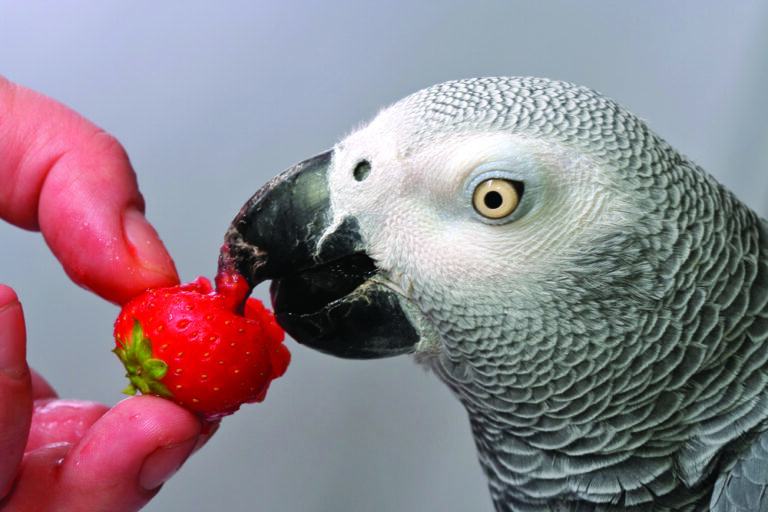
Introducing new foods to your parrot can be challenging, especially when it comes to getting them to eat vegetables or other healthy options.
However, with persistence and creativity, you can successfully expand your parrot’s diet. Here are ten tried-and-true methods to encourage your parrot to try new foods.
1. Lead by Example: Eat the New Food in Front of Your Parrot
Parrots are highly observant and learn by example, much like humans. When they see you eating and enjoying something, they are more likely to be curious and want to try it themselves.
Make a show of eating the new food with enthusiasm. If you have more than one parrot, a more adventurous eater can serve as a role model, encouraging the other bird to try the new food through mimicry.
2. Create a Sense of Intrigue: Refuse to Share the Food
A clever tactic suggested by Hilla Nieman involves making the food seem more desirable by refusing to share it. Act as if you are thoroughly enjoying the food and then leave a bit within the parrot’s reach while you turn away. This often triggers the parrot’s instinct to “steal” the food, making it irresistible.
3. Mix New Foods with Favorites
Blend the new food with something your parrot already loves. For instance, you can mix a new vegetable with a favorite fruit juice or pellets. Serving the mixture at room temperature or slightly warmed can also make it more appealing.
4. Incorporate New Foods into Familiar Recipes
Parrots often enjoy foods that are mixed into something familiar. You can mash the new food and cook it into “birdie bread” or a similar favorite dish. When the new ingredient is thoroughly integrated, it becomes harder for the parrot to pick it out and discard it.
5. Hang New Foods in the Cage
Suspending a new food item in your parrot’s cage can pique their interest. For example, hang a whole carrot (with the tops) from the cage bars using a clip, or use a food skewer to attach it. Pair the new food with something your parrot already likes to encourage them to investigate. Smaller birds, like budgerigars and cockatiels, may prefer food clipped to the side of the cage rather than placed in a bowl.
Note: Ensure that any clip or skewer used is made of safe materials like wood or stainless steel, especially when dealing with acidic foods to avoid exposure to toxic zinc.
6. Turn Feeding into a Foraging Game
Make feeding time fun by hiding pieces of the new food for your parrot to find. Place small pieces in paper cups and tuck them between the cage bars, some containing food and others empty or with toys to add an element of surprise. You can also hide bits of food in folded paper fans or inside small cardboard boxes.
7. Integrate Leafy Greens into the Cage Environment
Healthy leafy greens like parsley, kale, dandelion, and collard greens can be woven through the cage bars for your parrot to chew on. Wet the greens and place them on top of the cage; your parrot might enjoy a “leaf bath,” which can lead to nibbles and taste testing.
8. Offer Food in Different Preparations
Parrots have preferences for how their food is prepared. Some may like fresh foods grated, others sliced, some prefer raw, and others steamed. Experiment with different preparations to see what your parrot likes best. For example, my macaw prefers her vegetables slightly cooked and served warm or at room temperature.
9. Use Social Feeding Techniques
Finger feeding the new food to your parrot’s favorite human can be especially effective with larger parrots. Make sure to exaggerate your enjoyment with lip-smacking noises to signal pleasure and approval, encouraging your parrot to try the food.
10. Praise and Positive Reinforcement
Lavish your parrot with praise for even the smallest interaction with the new food. Touching is the first step to eating, so any contact with the new food should be celebrated. Positive reinforcement builds a positive association with the new food.
Persistence is Key: Never Give Up
The most crucial aspect of getting your parrot to try new foods is persistence. Pediatricians often advise parents to offer new foods to their children at least fifteen times before concluding that they don’t like it. The same principle applies to parrots. Continually offering the new food increases the chances that your parrot will eventually try and accept it.
For instance, it took several summers of offering sweet peppers from my garden before my macaw finally decided to try them—and now she loves them. Consistency and patience are essential.
Conclusion
Encouraging your parrot to try new foods requires creativity, patience, and a bit of strategy. By using these ten methods—leading by example, creating intrigue, mixing new foods with favorites, incorporating new foods into familiar recipes, hanging food in the cage, turning feeding into a foraging game, integrating leafy greens into the cage environment, offering food in different preparations, using social feeding techniques, and providing praise and positive reinforcement—you can successfully introduce a variety of healthy foods into your parrot’s diet.
Remember, the key to success is persistence. Don’t give up if your parrot doesn’t take to a new food immediately.
Keep offering it in different ways, and eventually, your feathered friend may surprise you by developing a taste for something new. By expanding their diet, you not only provide essential nutrients but also enrich their lives with new tastes and experiences.
